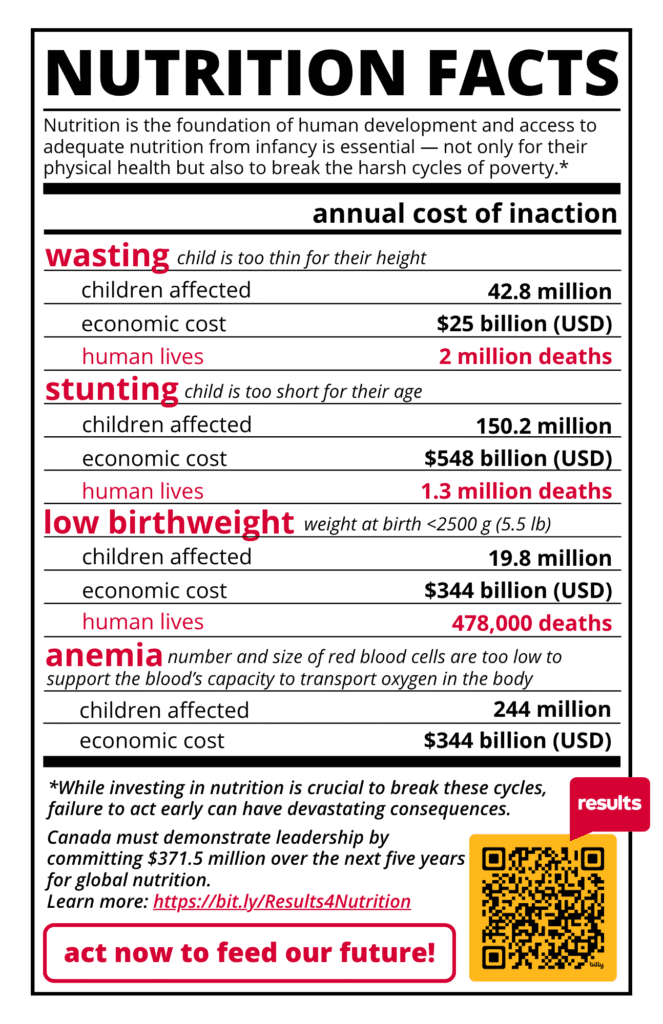
Nutrition is the foundation of human development, starting even before birth. A mother’s nutrition deeply impacts her child’s health, setting the stage for well-being from the very beginning. Ensuring that women and children have access to adequate nutrition is essential not only for their physical health but also to break cycles of poverty and to improve education outcomes. That’s why Canada needs to invest in global nutrition in a holistic way and help communities thrive and build a healthier, more equitable future.
Malnutrition disproportionately affects women and girls, who often eat last and least. Over one billion women and girls experience severe deficiencies in micronutrients (vitamins and minerals) that the body needs, with 40% of pregnant women globally suffering from anemia often due to a lack of iron. This condition increases risks of maternal mortality and poor birth outcomes. Children of undernourished women face a much higher risk of death within their first weeks of life, wasting, and severe illness, affecting generations.
Despite scientific progress and the proven success of high-impact interventions, rates of malnutrition are worsening. From 2020 to 2022, the rate of severe acute malnutrition in pregnant and breastfeeding women and adolescent girls increased by 25%.
Malnutrition is both a cause and a consequence of gender inequality. As a global leader in gender equity, Canada has the opportunity to allocate additional funding to break down the barriers preventing women from accessing vital nutrition and health resources.
Malnutrition is linked to nearly half of all child deaths under five. In addition, stunting (too short for age) and wasting (too thin for height) have irreversible effects, leading to cognitive delays, lower educational attainment, and limited economic opportunities. In 2024, 150.2 million children were estimated to be stunted and 42.8 million were estimated to be wasted. Today, wasting remains the most lethal form of malnutrition because – on top of the gaps in prevention – early detection and treatment are also not sufficiently accessible.
Even before children show physical signs of malnutrition, their growing brains and bodies are negatively affected. Consequences of undernourishment and micronutrient deficiencies are long lasting and hinder full potential growth of individuals and communities they live in, resulting in a global cost of US$ 761 billion annually. However, in 2025, the nutrition sector has been among the hardest hit by funding cuts from major donors, with only 27% of the required annual funding secured by the Fall. Early projections estimate that 2.3 million children could be left without treatment for severe wasting, resulting in up to 369,000 additional preventable child deaths each year.
In crisis-affected regions, severe wasting afflicts a child every minute. Nutrition support is just as vital in humanitarian crises as it is in long-term development efforts. A portion of Canada’s commitments should go toward providing early childhood development programs – including nutrition – to children living in conflict zones, where the risk of malnutrition is even higher.
Making matters worse, many communities remain cut off from nutrition services entirely. By integrating nutrition programs with broader healthcare services and strengthening networks of community health workers, Canada can help bridge this gap and bring critical support to those in remote areas.

While investing in nutrition is crucial to break these cycles, failure to act early can have devastating consequences.
Canada has an opportunity to demonstrate leadership by investing in nutrition.
By scaling up evidence-based interventions in areas with high rates of malnutrition and conflict-affected settings, and targeting the root causes of malnutrition, Canada’s support could help prevent 6.2 million infant deaths and nearly one million stillbirths, contributing significantly to global health and stability. Moreover, this new pledge would be a smart investment, with every dollar invested having the potential to yield 23 dollars in economic benefits.
By supporting global nutrition efforts, Canada can reaffirm its role as a global leader in health and gender equity and influence other donors to help end hunger worldwide.
wasting
stunting
Stunting can lead to irreversible physical and cognitive damage over the lifetime and even, in the next generation. Every year, 304M IQ points and 49M school years are lost because of this condition.
low birthweight
Babies born with low birthweight are more likely to die during the first month or to suffer from stunted growth and chronic conditions like obesity and diabetes later in life. It is also estimated that low birthweights leads to 168M IQ points being lost every year.
anemia (in children)
During pregnancy, anaemia has been associated with poor maternal and birth outcomes, including premature birth, low birth weight and maternal mortality. When combining the impact of anemia on young children, adolescents and women in a year, 50 million years of healthy life were lost due to disability. Iron deficiency anemia in children is also associated with diminished cognitive ability and affects school achievement.
Canada’s global leadership as a trusted nutrition champion matters now more than ever. We are proud of our history of:
FAO, IFAD, UNICEF, WFP and WHO. 2024. The State of Food Security and Nutrition in the World 2024 – Financing to end hunger, food insecurity and malnutrition in all its forms. Rome. https://doi.org/10.4060/cd1254en
Global nutrition targets 2030: anaemia brief. Geneva: World Health Organization and the United Nations Children’s Fund (UNICEF); 2025. https://doi.org/10.2471/B09484
Global nutrition targets 2030: child wasting brief. Geneva: World Health Organization and the United Nations Children’s Fund (UNICEF); 2025. https://doi.org/10.2471/B09520
Global nutrition targets 2030: low birth weight brief. Geneva: World Health Organization and the United Nations Children’s Fund (UNICEF); 2025. https://doi.org/10.2471/B09402
Global nutrition targets 2030: stunting brief. Geneva: World Health Organization and the United Nations Children’s Fund (UNICEF); 2025. https://doi.org/10.2471/B09383
Jain S, Ahsan S, Robb Z, Crowley B, Walters D. The Cost of Inaction: A Global Tool to Inform Nutrition Policy and Investment Decisions on Global Nutrition Targets. Health Policy and Planning, 2024. https://doi.org/10.1093/heapol/czae056
Osendarp S, Ruel M, Udomkesmalee E, Tessema M, Haddad L. The full lethal impact of massive cuts to international food aid. Nature. 2025 Apr;640(8057):35-37. doi: 10.1038/d41586-025-00898-3. PMID: 40140717.
Shekar, Meera, Jakub Kakietek, Julia Dayton Eberwein, and Dylan Walters. 2017. An Investment Framework for Nutrition: Reaching the Global Targets for Stunting, Anemia, Breastfeeding, and Wasting. Directions in Development. Washington, DC: World Bank. https://documents.worldbank.org/. License: Creative Commons Attribution CC BY 3.0 IGO
Shekar, Meera; Shibata Okamura, Kyoko; Vilar-Compte, Mireya; Dell’Aira, Chiara; eds. 2024. Investment Framework for Nutrition 2024. Human Development Perspectives Overview booklet. © Washington, DC: World Bank. http://hdl.handle.net/10986/42164 License: CC BY3.0 IGO.
United Nations Children’s Fund (UNICEF), World Health Organization, International Bank for Reconstruction and Development/The World Bank. Levels and trends in child malnutrition: UNICEF / WHO / World Bank Group Joint Child Malnutrition Estimates. Key findings of the 2025 edition. Geneva: World Health Organization; 2025. Licence: CC BY-NC-SA 3.0 IGO.
UNICEF. 2023. Low birthweight: A good start in life begins in the womb. https://data.unicef.org/topic/nutrition/low-birthweight
